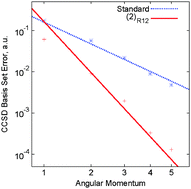Coupled-cluster methods with perturbative inclusion of explicitly correlated terms: a preliminary investigation
Abstract
We propose to account for the large basis-set error of a conventional coupled-cluster energy and wave function by a simple perturbative correction. The perturbation expansion is constructed by Löwdin partitioning of the similarity-transformed Hamiltonian in a space that includes explicitly correlated basis functions. To test this idea, we investigate the second-order explicitly correlated correction to the coupled-cluster singles and doubles (CCSD) energy, denoted here as the CCSD(2)R12 method. The proposed perturbation expansion presents a systematic and easy-to-interpret picture of the “interference” between the basis-set and correlation hierarchies in the many-body electronic-structure theory. The leading-order term in the energy correction is the amplitude-independent R12 correction from the standard second-order Møller–Plesset R12 method. The cluster amplitudes appear in the higher-order terms and their effect is to decrease the basis-set correction, in accordance with the usual experience. In addition to the use of the standard R12 technology which simplifies all  , are on average precise to (1.9, 1.4, 0.5 and 0.1%) when computed with Dunning’s aug-cc-pVXZ basis sets [X = (D, T, Q, 5)] accompanied by a single Slater-type correlation factor. This precision is a roughly an order of magnitude improvement over the standard CCSD method, whose respective average basis-set errors are (28.2, 10.6, 4.4 and 2.1%). Performance of the
, are on average precise to (1.9, 1.4, 0.5 and 0.1%) when computed with Dunning’s aug-cc-pVXZ basis sets [X = (D, T, Q, 5)] accompanied by a single Slater-type correlation factor. This precision is a roughly an order of magnitude improvement over the standard CCSD method, whose respective average basis-set errors are (28.2, 10.6, 4.4 and 2.1%). Performance of the  method is almost identical to that of the more complex iterative counterpart, CCSD(R12). The proposed approach to explicitly correlated coupled-cluster methods is technically appealing since no modification of the coupled-cluster equations is necessary and the standard Møller–Plesset R12 machinery can be reused.
method is almost identical to that of the more complex iterative counterpart, CCSD(R12). The proposed approach to explicitly correlated coupled-cluster methods is technically appealing since no modification of the coupled-cluster equations is necessary and the standard Møller–Plesset R12 machinery can be reused.


 Please wait while we load your content...
Please wait while we load your content...